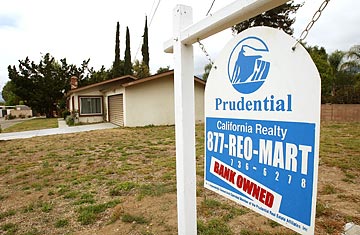
A bank-owned house is offered for sale in Pasadena, Calif.
In February, the Obama Administration said it would pay mortgage-servicing companies to modify existing home loans to make them more affordable — an attempt to keep struggling borrowers in their houses and slow the escalating pace of foreclosures. In a way, the problem was an odd one. Lenders lose a lot of money during foreclosures and shouldn't need incentives to prevent them. The complexities of mortgage securities and the uncertainty surrounding future home prices and the economy, it seemed, were gumming up the system. A government push would get the wheels moving.
Well, cold cash money doesn't seem to be doing the trick too well either. On Tuesday, July 28, executives from firms such as Citigroup, JPMorgan Chase and Wells Fargo were invited to a meeting at the Treasury Department for a little pep talk about increasing the number of loan modifications. Officials at Treasury, along with the Department of Housing and Urban Development (HUD; co-host of the head-knocking session), have been underwhelmed by the rewrites. The government's original goal was to get more-affordable monthly payments to 3 million to 4 million borrowers. As of mid-July, modification offers had gone out to 350,000 borrowers, but only 180,000 trial mods were under way, according to a report from the Government Accountability Office (GAO).
What accounts for the disappointing pace? According to Treasury and HUD, servicers aren't spending enough money or energy to make the program work. Treasury and HUD want the companies to add more staff, expand their call centers, train their representatives better, put more information online and create a system for dissatisfied borrowers to appeal their cases. To shame the firms into better participation, the government said that in August it will start revealing the number of modifications at each company and the long-term success of those rewrites.
But there's more to the holdup than a bunch of big companies dragging their feet. As the GAO report points out, Treasury itself has taken its time — perhaps legitimately — in rolling out details of the program. Only in late April did servicers get guidance on how to handle second liens. In May came information about dealing with geographic areas where home prices continue to decline quickly. Other details, like the process for modifying loans insured by the Federal Housing Administration, continue to emerge. It seems that writing the fine print for a program meant to spend up to $50 billion is tough to do quickly, especially when the office created to oversee it still has a large number of unfilled positions.
Furthermore, new research suggests that a key assumption made in creating monetary incentives for loan modifications — that economic self-interest would make firms eager to modify loans — may be wrong. Economists at MIT and the Federal Reserve banks of Boston and Atlanta have found that about 30% of borrowers who become seriously delinquent on their payments later catch up. A big deal has been made of the redefault rate — the high number of borrowers who wind up missing even modified payments — but the new finding about the large percentage of loans that "self-cure" indicates that servicers might actually be smart to delay rewriting many loans, since chances are they won't ultimately lead to foreclosure anyway. On top of that, servicers charge substantial penalty fees when loans are in delinquency or default — a source of revenue that goes away if a homeowner gets back on track.
Whatever the cause, the result is a system packed with pain for any homeowner looking for help. By the summer of 2008, Charles and Jennifer Lively knew they were going to start having trouble with the mortgage on their home in the Boise, Idaho, area, since Charles's paycheck (he works in plumbing, tied to new construction) had taken a major hit. They called their lender and were told there was nothing to do until they missed a payment. Eventually, the couple did and applied for a modification four different times but kept getting turned down. They desperately asked why and what they had to do to make it work, but they couldn't get a straight answer.
It's a story of frustration told time and again, even by professional housing counselors like Tom Birch, who last month finally landed the Livelys a modification. One day not too long ago, Birch got a call back from a servicer — a cause for celebration, considering how rarely his messages are returned. When he called the number back, the extension didn't work, but he tried not to let that dampen his excitement. His take: one step at a time.
For the feds, those steps need to come a little faster.
